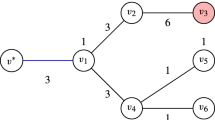Abstract
An undirected graph \(G=(V,A)\) by a set V of n nodes, a set A of m edges, and two sets \(S,\ D\subseteq V\) consists of source and demand nodes are given. This paper presents two new versions of location problems which are called the \(f(\sigma )\)-location and \(g(\sigma )\)-location problems. We define an \(f(\sigma )\)-location of the network N as a node \(s\in S\) with the property that the maximum expense transmission time from the node s to the destinations of D is as cheap as possible. The \(f(\sigma )\)-location problem divides the range \((0,\infty )\) into intervals \(\displaystyle \cup _{i}{(a_i,b_i)}\) and finds a source \(s_i\in S\), for each interval \((a_i,b_i)\), such that \(s_i\) is a \(f(\sigma )\)-location for each \(\sigma \in (a_i,b_i)\). Also, define a \(g(\sigma )\)-location as a node s of S with the property that the sum of expense transmission times from the node s to all destinations of D is as cheap as possible. The \(g(\sigma )\)-location problem divides the range \((0,\infty )\) into intervals \(\displaystyle \cup _{i}{(a_i,b_i)}\) and finds a source \(s_i\in S\), for each interval \((a_i,b_i)\), such that \(s_i\) is a \(g(\sigma )\)-location for each \(\sigma \in (a_i,b_i)\). This paper presents two strongly polynomial time algorithms to solve \(f(\sigma )\)-location and \(g(\sigma )\)-location problems.
















Similar content being viewed by others
Data availability
No data was used for the research described in the article.
References
Ageev AA (2008) Metric location problems with nonshortest service routes. J Appl Ind Math 2:311–316
Arya V, Garg N, Khandekar R, Meyerson A, Munagala K, Pandit V (2001) Local search heuristics for k-median and facility location problems, In: Proceedings of the ACM symposium on theory of computing, pp 21-29
Benkoczi R, Bhattacharya B, Das S, Sember J (2009) Single facility collection problem in the plane. Comput Geom 42:403–418
Chen Y, Chin Y (1990) The quickest path problem. Comput Oper Res 17:153–161
Chen G-H, Hung Y-C (1993) On the quickest path problem. Inf Process Lett 46:125–128
Daskin MS (2011) Network and discrete location: models, algorithms, and applications. John Wiley and Sons, USA
Goldman AJ (1971) Optimal center location in simple networks. Transp Sci 5:212–221
Hamacher HW, Drezner Z (2002) Facility location: applications and theory. Springer Science and Business Media, Germany
Handler GY (1973) Minimax location of a facility in an undirected tree graph. Transp Sci 7:287–293
Kariv O, Hakimi SL (1979) An algorithmic approach to network location problems, part I: p-centers. SIAM J Appl Math 37:513–538
Kariv O, Hakimi SL (1979) An algorithmic approach to network location problems, part II: p-medians. SIAM J Appl Math 37:539–560
Keshtkar I, Ghiyasvand M (2019) Inverse quickest center location problem on a tree. Discret Appl Math 260:188–202
Laporte G, Nickel S, da Gama FS (2015) Introduction to location science in location science. Springer, Germany
Megiddo N (1983) Linear-time algorithms for linear programming in \(R^{3}\) and related problems. SIAM J Comput 12:759–776
Mirchandani PB, Francis RL (eds) (1990) Discrete Location Theory. Wiley, New York
Nagy G, Salhia S (2007) Location-routing: issues, models and methods. Eur J Oper Res 177:649–672
Nguyen KT (2015) Reverse 1-center problem on weighted trees. Optimization 65:253–264
Nguyen KT (2020) Inverse Anti-centrum problem on networks with variable edge lengths. Taiwan J Math 24:501–522
Nguyen KT, Anh LQ (2015) Inverse k-centrum problem on trees with variable vertex weights. Math Methods Oper Res 82:19–30
Nguyen KT, Chassein A (2015) Inverse eccentric vertex problem on networks. CEJOR 23:687–698
Nguyen KT, Nguyen-Thu A, Hung NT (2018) On the complexity of inverse convex ordered 1-median problem on the plane and on tree networks. Math Methods Oper Res 88:147–159
Nguyen KT, Hieu VNM, Pham VH (2019) Inverse group 1-median problem on trees. J Ind Manag Optim. https://doi.org/10.3934/jimo.2019108
Pettie S (2004) A new approach to all-pairs shortest paths on real-weighted graphs. Theor Comput Sci 312:47–74
Pettie S, Ramachandran V (2005) A shortest path algorithm for real-weighted undirected graphs. SIAM J Comput 54:1398–1431
Pham VH, Nguyen KT (2019) Inverse 1-median problem on trees under mixed rectilinear and Chebyshev norms. Theoret Comput Sci 795:119–127
Tamir A, Halman N (2005) One-way and round-trip center location problems. Discrete Optim 2:168–184
Wang BF, Ye JH, Chen PJ (2016) Efficent algorithms for the round-trip 1-center and 1-median problems. J Comput Syst Sci 82:782–792
Acknowledgements
We would like to express great appreciation to the editor and anonymous reviewers for their valuable comments and suggestions, which have helped to improve the quality and presentation of this paper.
Funding
This study was not supported by any sponsor or funder.
Author information
Authors and Affiliations
Corresponding author
Ethics declarations
Conflict of interest
The authors have not disclosed any conflict of interests.
Additional information
Publisher's Note
Springer Nature remains neutral with regard to jurisdictional claims in published maps and institutional affiliations.
Rights and permissions
Springer Nature or its licensor (e.g. a society or other partner) holds exclusive rights to this article under a publishing agreement with the author(s) or other rightsholder(s); author self-archiving of the accepted manuscript version of this article is solely governed by the terms of such publishing agreement and applicable law.
About this article
Cite this article
Ghiyasvand, M., Keshtkar, I. Minimizing the expense transmission time from the source node to demand nodes. J Comb Optim 47, 47 (2024). https://doi.org/10.1007/s10878-024-01113-1
Accepted:
Published:
DOI: https://doi.org/10.1007/s10878-024-01113-1




